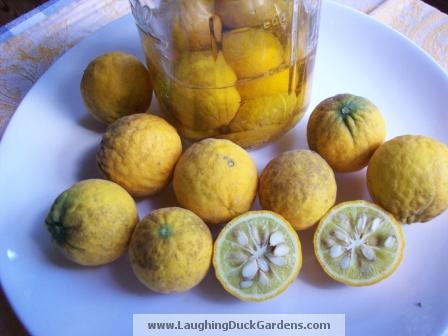Yesterday I wrote about Meyer lemon trees,
the small citrus fruit trees sold as table-top potted plants
by big box stores and garden centers
In the course of my research for how to grow a Meyer lemon tree,
I came upon some information about wild lemon trees in Virginia.
Imagine my surprise to learn we have lemon trees here.
The wild lemon tree in Virginia is called a poncirus trifoliata:

Of course the first things one notices in the photo are the roundness of the lemons
and the proliferation of long pointy thorns on the branches.
You wouldn't want to run into one of those in the dark.
These wild lemons can be grown in the home garden as well:

Imagine walking in the woods and being suddenly enveloped
by a deep and heady lemon scent.
That would cause one to pause and check it out.
I've read accounts of people harvesting the lemons in the wild
and using them sliced in tea or in cooking.
Here's an image of wild lemons (some call them poncirus oranges)
owned by Sylvie Rowand and shown on her web site
Rappahannock Cook and Kitchen Gardener.
Her web site looks like a lot of fun and so very interesting.
Here's the link if you want to check it out further:

The fruit isn't as pretty as commercially grown fruit, and it is full of pits.
My mom would describe the look as "scrubby."
But I've read that the flavor of the wild lemon is the same as regular lemons,
so it would be easy enough to overlook their shabby appearance
if cooking with them.
I've never run across a wild lemon tree
on any of my hikes into the maritime forest,
but I would like to have the experience of finding one some day.
They must not be as prolific here in the southeast corner of the state
as further north and central in Virginia.
Still, finding a lemon tree this far north of Florida--
that would be wild. ;-)
<>
1 comment:
Poncirus has a bitterness not found in other citrus. In addition, there is very little juice in the fruit, as it is mostly seeds. Some people do find it edible, especially if they are careful to avoid the rind. It is hardy to Zone 5 at least.
Post a Comment